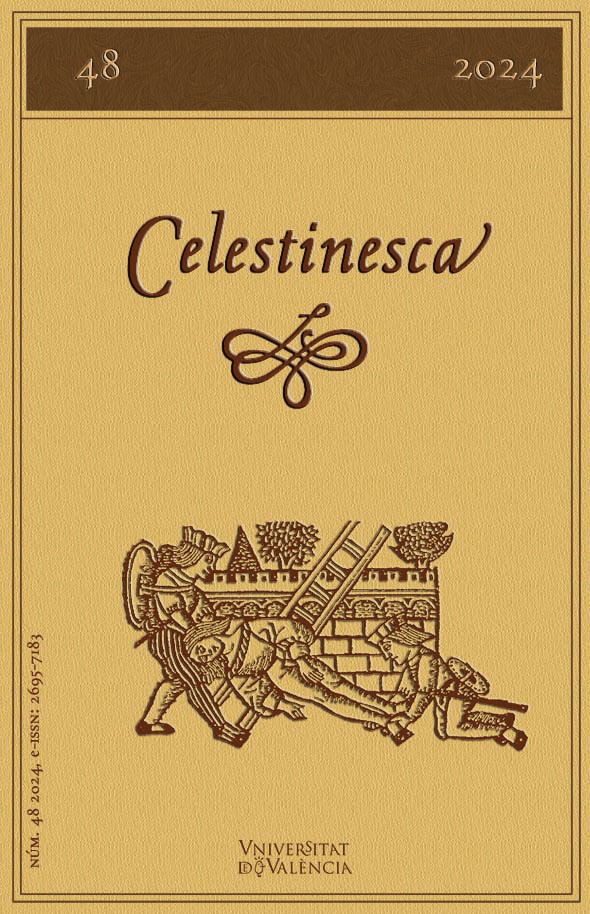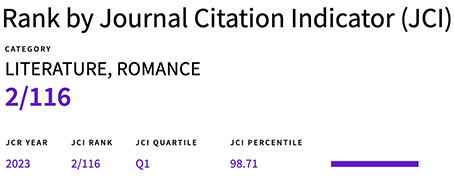An envious groom? A faithful servant?: Towards a new characterisation of Parmeno in La Celestina
DOI:
https://doi.org/10.7203/Celestinesca.48.27569Keywords:
Parmeno, Age, Celestina, Areusa, Corruption, Servant Abstract
Abstract
Parmeno has been studied by many scholars as the representation of a faithful servant who is eventually corrupted by Celestina. This image of the Parmeno is based on a specific characterization of the servant as young, inexperienced, and uneducated, who aspires to ideals and values that are not proper to his condition, and consequently destined to be corrupted by the old bawd. Yet, these readings tend to take the words of Celestina and other characters as definitive, ignoring the information that Parmeno himself gives about his life. In this article, instead of approaching the character from what other characters say about him, we take the information given by Parmeno himself and his actions through the text to propose a new reading of the servant that can give us a more complete and accurate image of the character. Image that departs significatively from what the scholarship has shown until now.
 Downloads
Downloads
 References
References
Bataillon, Marcel. «La Célestine» selon Fernando de Rojas. Paris, Marcel Didier, 1961.
Barón Palma, Emilio. «Pármeno: la liberación del ser auténtico: el antihéroe». Cuadernos hispanoamericanos, no. 317, 1976, p. 383-400.
Beltrán, Rafael. «Del suicidio de Judas al salto de Pármeno: codicia, traición y caídas mortales en La Celestina». Celestinesca, vol. 44, 2020, pp. 9-80. https://doi.org/10.7203/Celestinesca.44.19428
Bernaschina Rivera, Vicente. «Las políticas de la amistad en La Celestina: el caso de Pármeno». Celestinesca, vol. 34, 2021, pp. 9-28, https://doi.org/10.7203/Celestinesca.34.20121
Berndt, Erna Ruth. Amor, muerte y fortuna en «La Celestina». Madrid, Gredos, 1963.
Celestina comentada, editado por Louise Fothergill-Payne, Enrique Fernández Rivera y Peter Fothergill-Payne. Salamanca, Universidad de Salamanca, 2002.
Gerli, Michael. «A propos the pantomime ox, sexual inuendo, and fuddled partridges: yet more on Parmeno’s remark». Celestinesca, vol. 12, 1988, pp. 55-59, https://doi.org/10.7203/Celestinesca.12.19684
Gerli, Michael. «Complicitous laughter: hilarity and seduction in Celestina». Hispanic Review, vol. 63, no. 1, 1995, pp. 19-38, https://doi.org/10.2307/474376
Gil-Oslé, Juan. «La amistad, el remedio de la fortuna en La Celestina». Celestinesca, vol. 29, 2005, pp. 171-195. https://doi.org/10.7203/Celestinesca.29.20050
Gilman, Stephen. «La Celestina»: arte y estructura, traducido por Margit Frenk. Madrid, Taurus, 1974.
Heusch, Carlos. «Las desviaciones de Pármeno o la caída de un ángel». Celestinesca, vol. 26, no. 1-2, 2021, pp. 29-44, https://doi.org/10.7203/Celestinesca.26.19986
Joset, Jacques. «De Pármeno a Lazarillo». Celestinesca, vol. 8, 1984, pp. 17-24. https://doi.org/10.7203/Celestinesca.8.19593
Lacarra, María Eugenia. Cómo leer «La Celestina». Barcelona, Jucar, 1990.
Lida de Malkiel, María Rosa. Originalidad artística de «La Celestina». Buenos Aires, EUDEBA, 1962.
Maravall, José Antonio. «Calisto y los criados: la desvinculación de las relaciones sociales» en Historia y crítica de la literatura española. vol. 1 La Edad Media, editado por Francisco Rico y Alan Deyermond. Barcelona, Crítica, 1979, pp. 513-516.
Maravall, José Antonio. El mundo social de «La Celestina». Madrid, Gredos, 1964.
Márquez Villanueva, Francisco. Orígenes y sociología del tema celestinesco. Barcelona, Antropos, 1993.
Montero Moreno, Ana. «La enfermedad de Areúsa en Celestina y la defensa de las mujeres en Cárcel de Amor» en Dueñas, cortesanas y alcahuetas: «Libro de Buen Amor», «La Celestina» y «La Lozana Andaluza», editado por Francisco Toro Ceballos. Alcalá la Real, Ayuntamiento de Alcalá la Real, 2017, pp. 229-238. En línea: https://cvc.cervantes.es/literatura/arcipreste_hita/05/montero.htm [consultado el 09/03/2024]
Morros Mestres, Bienvenido. «Areúsa en La Celestina: de la Comedia a la Tragicomedia». Anuario de Estudios Medievales, vol. 40, no. 1, 2010, pp. 355–85, https://doi.org/10.3989/aem.2010.v40.i1.307
Ramírez Figueroa, Adán. «La construcción del pasado como estrategia de poder en La Celestina». Letras, vol. 78, 2018, pp. 37-50. En línea: https://erevistas.uca.edu.ar/index.php/LET/article/view/2069 [consultado el 09/03/2024]
Rodríguez Velasco, Jesús. «¿Dante por boca de Pármeno? Opiniones, sectas y discreción». Estudios Románicos, vol. 8-9, 1993-1995, pp. 133-142. En línea: https://revistas.um.es/estudiosromanicos/article/view/79691 [accedido el 09/03/2014]
Rojas, Fernando de. La Celestina, editado por Dorothy S. Severin. Madrid, Cátedra, 2020.
Rojas, Fernando de. La Celestina. Comedia o Tragicomedia de Calisto y Melibea, editado por Peter Russell. Madrid, Castalia, 1991.
Russell, Peter. «La magia: tema integral en La Celestina» en Estudios sobre «La Celestina», coordinado por Santiago López-Ríos. España, Istmo, 2001, pp. 281-311.
Severin, Dorothy S. «Celestina: a life». Celestinesca, vol. 25, no. 1-2, 2001, pp. 101-106. https://doi.org/10.7203/Celestinesca.25.19975
Severin, Dorothy S. Memory in «La Celestina». London, Tamesis Books, 1970.
Snow, Joseph. «"¿Con qué pagaré esto?": The life and death of Pármeno». Bulletin of Hispanic Studies, vol. 66, sup. 1, 1989, pp. 185-192. https://doi.org/10.1080/14753820.1989.11434978
Snow, Joseph. «Confederación e ironía: crónica de una muerte anunciada (Celestina, autos I-XII)». Celestinesca, no. 37, 2013, pp. 119-138. https://doi.org/10.7203/Celestinesca.37.20161
Tozer, Amanda. «La identidad masculina en Celestina: la emasculación de Pármeno». Celestinesca, vol. 27, 2003, pp. 149-164. https://doi.org/10.7203/Celestinesca.27.20024
Vilchis Fraustro, José Carlos. «Pármeno envenenado: sexo y traición en La Celestina». Destiempos 56, 2017, pp. 7-33.
Downloads
Published
How to Cite
-
Abstract187
-
PDF (Español)50
Issue
Section
License
Copyright (c) 2024 Adan Ramirez Figueroa

This work is licensed under a Creative Commons Attribution-NonCommercial-NoDerivatives 4.0 International License.
![]() Celestinesca is committed to the dissemination of knowledge, that is why access to its contents is free and is ruled by a Creative Commons Attribution-NonCommercial-NoDerivatives 4.0 license.
Celestinesca is committed to the dissemination of knowledge, that is why access to its contents is free and is ruled by a Creative Commons Attribution-NonCommercial-NoDerivatives 4.0 license.
Authors retain the rights to their works. Therefore, they can disseminate them and deposit them in the repository, institutional or not, that they wish. However, they are kindly requested to do so by providing the full bibliographic reference and the corresponding DOI.
Celestinesca does not charge authors for submitting, processing, reviewing or publishing their articles.





